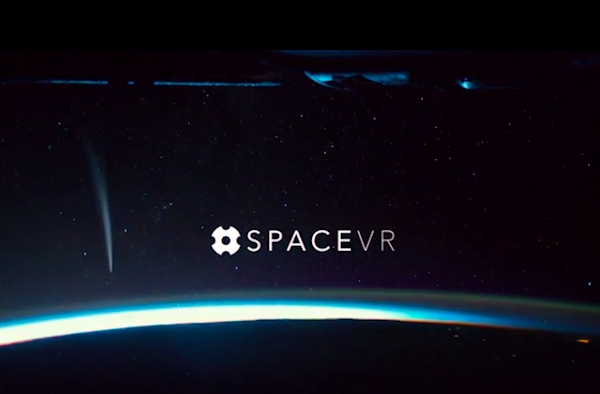[This project, especially the ‘down the road’ possibilities such as being able to join astronauts on space walks in real-time – has exciting potential. The story is from The Verge, where it features a different image and a 4:39 minute video. –Matthew]
SpaceVR launches a Kickstarter to make virtual reality movies in space
Orbit the Earth from your couch
By Sean O’Kane
on August 10, 2015
If you want to go to space, you either need a Donald Trump-sized fortune or the kind of patience only the Dalai Lama can relate to. A new company called SpaceVR wants to change all that, and if it’s successful you’ll just need $10 and a VR headset to orbit the Earth.
The company launched a Kickstarter today to make this happen. The plan is to send a tiny 12-camera rig that shoots three-dimensional, 360-degree video to the International Space Station aboard a resupply mission in December. New virtual reality footage will be available every week, but will only be accessible with a subscription. As Isaac DeSouza, SpaceVR’s cofounder and CTO puts it, “it’s like Netflix, except you get to go to space.”
SpaceVR is asking for $500,000 to cover launch costs and the first year of operations, with backer levels that start at one dollar and go all the way up to what DeSouza calls the “extreme experience” — watching the VR footage while on a parabolic flight. (In the space industry, planes that make parabolic flights are lovingly known as “vomit comets.” When I told SpaceVR CEO Ryan Holmes that pairing that type experience with the sometimes dizzying side effects of VR sounded tenuous, he joked, “you’ll just have to throw up before you go.”)
You can get a year-long subscription to SpaceVR up front by donating $250, which also grants you early access to the content. Other donation rewards include things like 3D models and files of the camera, a Google Cardboard headset, and there are even levels where you can sponsor a classroom or entire school’s worth of access to SpaceVR.
The camera — named “Overview One” after the famous “overview effect” — will record up to two hours of footage at a time. The first footage will be recorded in the Space Station’s Cupola Observatory, a bulbous compartment with seven windows that offer dizzying views of the spinning Earth below. Once SpaceVR gets a few recording sessions out of the way, they’ll have the astronauts move the camera to different places around the ISS.
Eventually the goal is to live stream the virtual reality experience, but the problem right now is bandwidth — specifically, the ISS’s connection to the Earth. The space station can send data to Earth at 300 megabits per second, but companies with equipment on board only have access to half of that. SpaceVR will have access to anywhere from three to six megabits per second at all times, thanks to its partner company NanoRacks, which runs the commercial laboratory aboard the space station. But DeSouza says they will be requesting more. SpaceVR would need access to around 60 megabits per second to do high-quality live streaming virtual reality from the space station, DeSouza says.
Way down the road DeSouza and Holmes envision a number of other possibilities for their virtual reality experiences, like joining astronauts on spacewalks, or riding in the spacecraft with them as they re-enter the Earth’s atmosphere. But that will all have to wait until the first footage has been sent back and everything looks okay. “We’re so dead-focused on ‘just get it done’ that the whole storytelling aspect is something we’re going to have to look at afterwards,” Holmes says.
After my conversation with Holmes and DeSouza, they showed me some footage they filmed with a prototype camera during SpaceX’s recent (failed) launch. I was given a Galaxy Note 4 version of the Gear VR and some noise canceling headphones, and for three minutes I got to pretend I was standing at Cape Canaveral watching a Falcon 9 rocket take off. I’ve heard enough about the powerful beauty of rocket launches to know there’s no substitute for being there. But virtual reality was definitely the next best thing.
